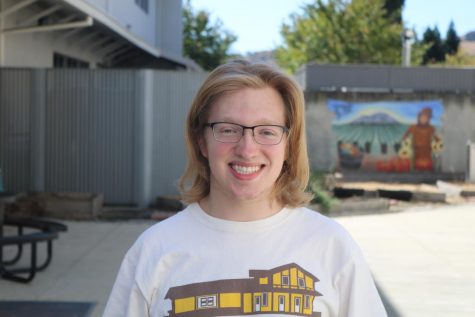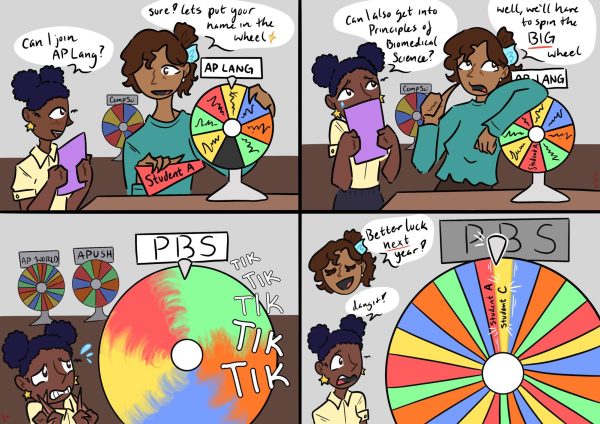Student Senate gives teens a voice
Photo by Asher Thomas Riccardi-Holloway
From left to right, Nicholas Harvey, Evelyn Ramos and Elena Patro are part of the Student Senate this year. Read Patro and Ramos’ column about their experience with the Equity Subcommittee at thecalifornianpaper.com.
In the first year of the San Ramon Valley Unified School District Student Senate, the Student Voice Subcommittee (SVS) has primarily led two student voice efforts: pushing for a student board member on the county board of education, and trialing a participatory budgeting program in the district.
The SVS is currently leading an effort to circulate a petition to create a student position on the county board of education. Assembly Bill 824 requires county boards of education to create at least one student position starting the 2023-24 school year if a petition is submitted from 500 public high school students in the county. We expect to have 500 signatures by the end of the school year.
The subcommittee also led a participatory budgeting trial at Cal High, allowing students to create proposals for spending $1,300 of the library budget and then vote on them.
The creation of the Student Senate and a student board member position last spring, as well as our steps toward increasing student voice this year, is important, but there is still much that can and needs to be done.
1. Implementing a district-wide participatory budgeting program
Building on the trial the Student Senate conducted this year, the district should implement participatory budgeting district-wide, at all schools. Yes, that includes elementary schools.
In May 2017, Primary School 139 in New York City allowed elementary students to vote on how to spend $8,000 of the school’s money. Parents were allowed to vote yet most votes came from students, potentially serving as an example for participatory budgeting in our elementary schools, where parents could have more involvement than in middle or high schools.
The SVS has already contacted the district to discuss scaling up participatory budgeting and we look forward to working with the district on bringing this innovative democratic policy tool to our community.
2. Converting the Student Senate into a democratically elected body
In its current form, the senators that make up the Student Senate are appointed by their principal. Although the presence of students at the table is important, it is also important that students with a say in decision-making represent the will of their student body.
Each school site should hold an election at the start of the school year so students can vote on who should represent them in the Senate.
Additionally, the student board member should be elected by the students of the district. It is too late to use an election to choose the student board member for next year, but the district should switch to elections starting in 2023-24.
The most common argument I hear in opposition to a democratic Student Senate is that students would treat elections as a popularity contest.
Assuming that the “popularity contest” is a real trend, it can be neutralized through education. For Site Council, ASB, and leadership elections there is generally a lack of information about the students running, which can be fixed by putting more candidate information on the ballot and in other communication channels that students use.
Additionally, most students don’t have strong views on planning a dance or fundraisers, leading to a lack of engagement with ASB and leadership elections. When students are expected to vote for positions that can influence the issues that are relevant to them, like curriculum or district facilities, they have and will rise to the task. Students in San Diego Unified and other districts across the state have successfully elected their student board members.
Finally, the geographic influence of any one school in a district-wide student board member election can be reduced by allowing middle schoolers to vote as well as high schoolers, as is done in student board member elections in Howard County, MD.
Electing Student Senators may not be perfect but it has clear advantages compared to a non-democratic system, namely that it will improve civic engagement and allow students to have elected representation in the district.
3. Creating a method for students and community members to suggest policy proposals to the district
Each year, the California Association of Student Councils hosts a conference called SABLE, where students from across the state gather to draft proposals for education bills to be presented at the Capitol in Sacramento.
Our district would be wise to create a similar conference where students work with administrators to create policy proposals to be considered.
The district can utilize the Student Senate, as well as CASC’s Region 4 cabinet, which includes Contra Costa County, to help design a mini-SABLE. The Region 4 cabinet can also provide technical assistance and knowledge of SABLE as a foundation to build a local equivalent.
4. Recognizing 16- and 17-year-olds’ right to suffrage in board elections
Acknowledging our right to suffrage would follow in the footsteps of Oakland Unified School District, which allows 16-year-olds to vote in school board elections after the passage of Measure QQ in 2020. Oakland granted the right to suffrage by amending its City Charter to allow 16-year-olds to vote in school board elections.
San Ramon, as a charter city, could theoretically do the same. But the boundaries of the City of Oakland and OUSD overlap exactly, while our district includes multiple cities, complicating the mechanics of how our right to suffrage would be fulfilled.
The district should start a dialogue with San Ramon, Danville, and the county to develop a plan for recognizing our right to suffrage in school board elections. District Board Policy 1160 Community Relations clearly states: “The Board’s responsibility as an advocate for the district may include lobbying and outreach at the state, national, and local levels.”
Hundreds of 16- and 17-year-olds in our district pay taxes while also having no representation in government. Being able to cast a vote for who represents us on the school board is an important step in fixing this contradiction with our country’s basic founding principle: no taxation without representation.
None of the policies I am advocating for are unrealistic. They have all been done in districts around the country. You can help advocate for the aforementioned policies by writing emails to the district and sharing this article to others.
The policies I’m proposing are popular among students. In a survey of 455 district students the SVS conducted last year, large pluralities supported giving 16-year-olds suffrage and electing the student board member. We won’t have these pro-student policies unless we advocate for ourselves.

Senior Nicholas Harvey is the Editor-in-Chief for The Californian. Writing for the paper since freshman year, Nicholas is especially interested in the...


